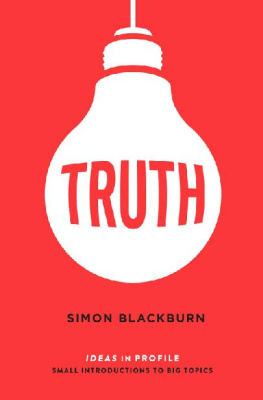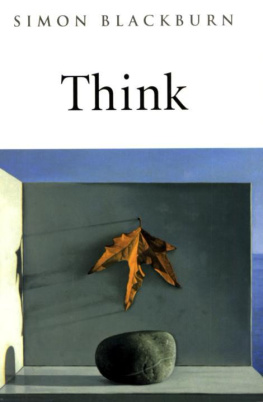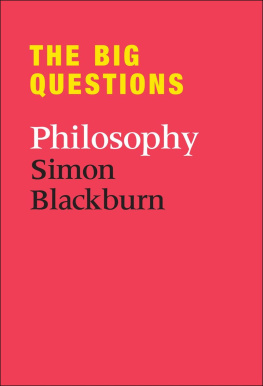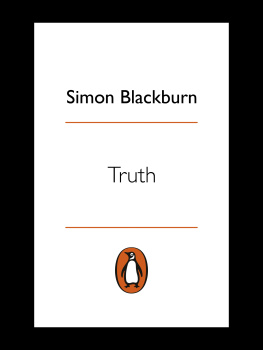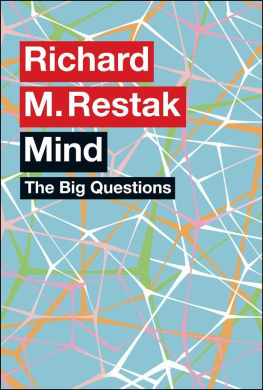TRUTH
SIMON BLACKBURN was the Bertrand Russell Professor of Philosophy at the University of Cambridge and remains a Fellow of Trinity College. He is known for his appearances in the British media such as BBC Radio 4s The Moral Maze and his many publications which span popular and academic moral philosophy. His books include Spreading the Word (1984), The Oxford Dictionary of Philosophy (1994), Ruling Passions: A Theory of Practical Reasoning (1998), Think: A Compelling Introduction to Philosophy (2001), Being Good: A Short Introduction to Ethics (2002), Lust: The Seven Deadly Sins (2003), and Mirror, Mirror: The Uses and Abuses of Self-Love (2014).
ALSO BY SIMON BLACKBURN
Reason and Prediction
Philosophical Logic
Spreading the Word
Essays In Quasi-Realism
The Oxford Dictionary of Philosophy
Ruling Passions
Think: A Compelling Introduction to Philosophy
A Very Short Introduction to Ethics
Lust
Truth: A Guide for the Perplexed
Platos Republic
How to Read Hume
Mirror, Mirror: The Uses and Abuses of Self-Love
Edited
Meaning, Reference and Necessity
Edited with Keith Simmons
Truth
TRUTH
SIMON BLACKBURN
First published in Great Britain in 2017 by
PROFILE BOOKS LTD
3 Holford Yard
Bevin Way
London WC1X 9HD
www.profilebooks.com
www.profilebooks.com
Copyright Simon Blackburn 2017
The moral right of the author has been asserted.
All rights reserved. Without limiting the rights under copyright reserved above, no part of this publication may be reproduced, stored or introduced into a retrieval system, or transmitted, in any form or by any means (electronic, mechanical, photocopying, recording or otherwise), without the prior written permission of both the copyright holder and the publisher of this book.
All reasonable efforts have been made to obtain copyright permissions where required. Any omissions and errors of attribution are unintentional and will, if notified in writing to the publisher, be corrected in future printings.
A CIP catalogue record for this book is available from the British Library.
eISBN 978 1 78283 292 8
CONTENTS
PREFACE
This is the third book under my name with the word truth in the title, so perhaps some explanation is in order. The first was a collection of classic philosophical and logical writings that my erstwhile colleague Keith Simmons and I put together in 1999, as a title in the series of Oxford Readings in Philosophy. So, apart from my contribution to our joint introduction, it was by no means an exposition of my own views. The second I billed as a Guide for the Perplexed, and it wrestled above all with problems of scepticism and relativism, perhaps more prevalent in the carefree postmodern world at the turn of the millennium than they are at present. It was easier then to think that anything goes, when nothing much in the way of war, religious intolerance and terrorism was going on, than it is now, when they are pervasive features of everyday life. In that book I took to task some philosophers, particularly Richard Rorty and Donald Davidson, who seemed to me to have come too close to a relativistic view of truth. But when fine philosophers go astray, there is usually some truth in the offing, and this book tries to do fuller justice to the pragmatist strain in each of those writers, and to others in the pragmatist tradition.
So the approach of this book is very different. It briefly lays out the classical approaches to understanding the notion of truth, but then devotes the second half of the book to some areas, such as aesthetics, religion, ethics and interpretive disciplines, where truth can seem especially fugitive and endlessly contestable. The aim is to show that a better understanding of all our practices with the notion of truth arises if we take seriously the point of Jeremy Benthams and C. S. Peirces remarks (see epigraph on ). What this means has to unfold in due course, but when it does we gain not only a new perspective on the old problem of truth, but a new sense of the practices of philosophy itself. The selection of topics is necessarily partial, since philosophers have pursued issues of truth and our attempts to find it in more areas than I have space to talk about. Perceptual judgement, mathematical investigations, scientific truth, truth about possibilities and necessities, give rise to their own huge literatures. But in order to avoid superficial treatments of too many things I have instead tried to follow a particular thread, to see where it takes us in a limited number of especially contentious areas. I hope it will be evident how the thread can be extended further, and it will be an exercise for the reader to think about that. Philosophy, like gardening, needs to be practised to be understood, and although I hope to provide tips, suggestions and examples to follow, the point has to be to initiate a process, not to deliver a finished product. To whet peoples appetites, I might say that this is also the moral I am deriving from Bentham and Peirce.
I have been indebted over the years to many colleagues, friends and writings. I would like particularly to mention Edward Craig, Allan Gibbard, Robert Kraut, Huw Price and Michael Williams, who have all influenced the way I think about these things. I owe a great deal to Chris Hookways and Cheryl Misaks work on the American pragmatist tradition. I owe the stimulus to think about truth in law to Andrew Stumff Morrison, and the fascinating, and to me new, material on Thomas Hobbes to Thomas Holden. I owe thanks to Catherine Clarke for encouragement, and to John Davey for his faith in the project.
Stretching his hand up to reach the stars, too often man forgets the flowers at his feet.
Jeremy Bentham
We must not begin by talking of pure ideas vagabond thoughts that tramp the public highways without any human habitation but must begin with men and their conversation.
C. S. Peirce
PART I
THE CLASSIC APPROACHES
There is an air of divinity that hangs over the concept of truth. Truth is the goal of enquiry, the aim of experiment, the standard signalling the difference between it being right to believe something, and wrong to do so. We must court it, for in its absence we are bewildered or lost or may even be facing the wrong way, on the wrong track altogether. Deception is an insult to this divinity, as well as an insult to its target. Sometimes, perhaps more often than we think, truth hides itself, and we have to put up with simplifications, models, idealisations, analogies, metaphors and even myths and fictions. These may be useful, but we think of them as only at best paving the way to the altar of truth. Sometimes we have to settle for mere opinion or guesswork, but the god of truth is better served by attendant deities, such as reason, justification and objectivity. Once we have it, truth radiates benefits such as knowledge and, perhaps most notably, success in coping with the world.
It is theology that tries, with doubtful success, to unravel the nature of other deities, but it is philosophy that wrestles with the nature of truth. How does it set about doing so?
CORRESPONDENCE
A good map corresponds with the landscape. If, in accordance with the mapping conventions, there is a symbol showing a road at some place, then there is a road there, if it shows a river, then there is a river, and so on. The conventions are not always obvious. We may not even know which bit of land the map is describing (think of pirates treasure maps), and we may not know the conventions. A short red line does not look much like a road, and a thin blue line not much like a river, and some maps ignore conventions that others use. Famously, the distances shown between stations on the classic London Underground map do not correspond with the actual distances on the ground in a systematic way, whereas on most maps they do. Hence reading a map is a skill that needs teaching. But once the conventions are understood, a good map will correspond with what is found on the ground. A good portrait corresponds with a face even more readily, since a portrait can look significantly like a face one might even mistake one for the other in a bad light whereas a map does not generally look like a landscape. Both, of course, can go wrong. Bad maps or portraits do not correspond with their target in the way they should.



